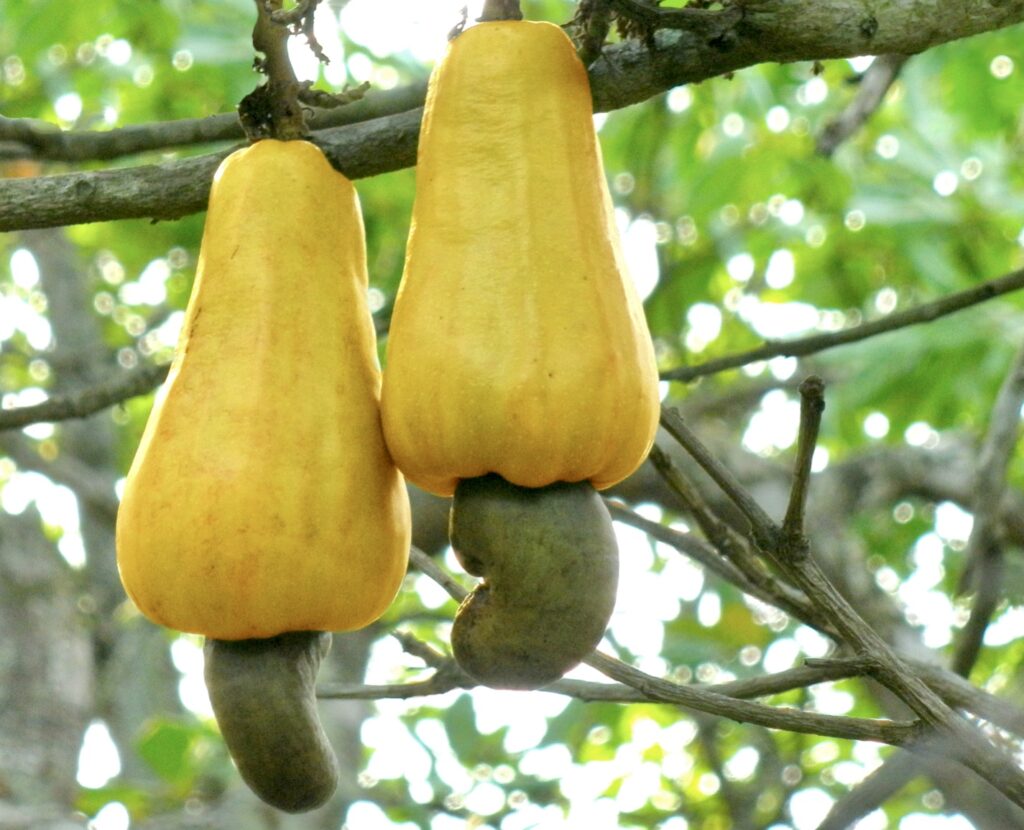By Henrylito D. Tacio
If there is a tree to which the phrase “money grows on trees” applies so well, it is the cashew tree (scientific name: Anacardium occidentale). So many food and industrial uses have been found for parts of the tree.
Cashew is grown primarily for its kernel or nut. Dried or roasted, cashew nuts are one of the world’s most popular nut foods. One cashew tree produces between 200 and 300 cashew nuts in a year.
Sixty percent of cashew kernels are consumed in the form of snacks while the remaining 40 percent are included in confectionery. In the Philippines, local processors use only the roasted and dried kernel in the manufacture of ice cream, confectionaries, and hardener for chocolate and pastries.
Today, cashew nut is second to almond in value – and fast becoming in great demand. The reason: health experts and nutritionists considered it as “nature’s vitamin pill.”
Cashew nuts has various health advantages as they are significant sources of iron (essential for red blood cell function and enzyme activity), magnesium (promotes energy release and bone growth), phosphorus (builds bones and teeth), zinc (essential to digestion and metabolism) and selenium (has important antioxidant properties, thus protecting the body from cancer). Cashew nuts are also good sources of protein.
The nut has other uses. It contains a light-yellow oil that is like almond oil. The oil is used to protect posts, floors, and rafters from termites and as waterproofing and preservative for fishing lines, nets, boats, bamboo screens and light woodwork; as an insect repellant; and as a water-resistant adhesive in making bamboo boards.
Another possible source of income for farmers is the shell of the nut, which is a good source of an important liquid called CNSL (cashew nut shell liquid). CNSL is one of the few natural resins that is highly heat resistant and is used in braking systems and in paint manufacture. It contains a substance called phenol, which is used in the preparation of plastics. A mixture of five percent CNSL and 95 percent kerosene or diesel oil is an effective mosquito larvicide.
The second most important product of cashew is its fruit or apple. Although acrid tasting, the apple is juicy and has considerable food value. When fully ripe, the apple can be eaten fresh or can be used in making marmalades, jams, and jellies, pie stock, vinegar, chutney, alcohol, and wine. The unripe apple is used in the preparation of curried vegetables and pickles.
The juice, after its astringent and acrid substances are removed, has been found suitable for production of several beverages. The juice can also be brewed into wine for local consumption and for export.
Cashawa gum – exudates from incisions in the trunk – is used to protect books and wood carvings from insects. It is also used as a substitute for gum Arabic in adhesives and other products.
“If industrially exploited, the cashew tree can help alleviate many of our socio-economic problems by offering employment to the many unemployed,” said the forestry department of the University of the Philippines at Los Baños (UPLB). “A cashew cottage industry can easily absorb idle manpower in the rural areas since only the normal skills of the workers are required in processing many cashew products.”
Although the tree thrives in areas where other agricultural crops would barely survive, there simply are not enough cashew trees planted. “Planting cashew trees in idle lands may be the best solution to our land conservation problem,” the UPLB forestry experts pointed out. “As an agricultural crop, cashew trees provide vegetative cover to barren lands and help minimize soil erosion. There is also money in cashew.”
Cashew is hardy and can grow well on dry soil, sandy open beaches, and poor laterite soil. Leaf and grass mulching and composting around each tree give the cashew tree moisture during the dry season. It can also thrive well on soils that are too poor and too dry for other crops. It requires no cultivation, irrigation, and fertilization.
Unknowingly, cashew possesses some medicinal properties. A decoction of the bark has been used as a remedy for diabetes, diarrhea, and syphilitic swellings of joints. An infusion of the bark and leaves may be used as an astringent and can be applied as a lotion or as mouthwash to relieve toothache and sore gums. The raw juice is used to alleviate stomach disorders and arrest vomiting.
The cashew was formerly thought, by some writers at least, to be indigenous both in America and Asia. It has been shown, however, that it was originally confined to America, whence it was carried to Asia and Africa by early Portuguese voyagers.
The early missionaries introduced cashews from South America and India to the Philippines. Today, it grows abundantly in Palawan, Mindoro, Nueva Ecija, Cavite, Zambales, and Bataan. It can also be found in other parts of the country. — ###
(Photos courtesy of Wikipedia)



